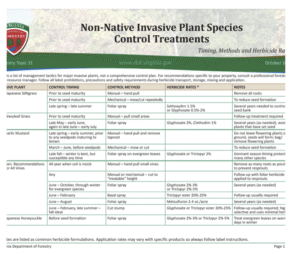Invasive Plants to Watch This Month
There are several invasive plants that should be on your radar:
- Autumn Olive (Elaeagnus umbellata)
- Porcelain Berry (Ampelopsis brevipedunculata)
- Tree-of-Heaven or Ailanthus (Ailanthus altissima)
Read about Autumn Olive and Porcelain Berry in this month’s Tasks & Tips article: September in the Ornamental Garden.
Identifying Autumn Olive
Identifying Porcelain Berry
Now is the time to start looking out for the bright berries of the porcelain berry. Reduce its spread by preventing flowering and fruiting. This video can help you identify it:

Control of Porcelain Berry: “Herbicidal foliar treatment is most effective when applied between midsummer and early fall. Cut-stump bigger vines, applying an herbicide immediately to the cut. If you can reach the largest stems in the tangle, use a basal bark application.” — Invasive Plant Control Calendar, The Garden Shed (May 2022)
Controlling Autumn Olive
Autumn olive is difficult to eradicate once it reaches a certain size. It usually takes several years to completely kill the roots. If dealing with large ones, at least cut the flowers and berries. Foliar herbicide applications are recommended in summer through September. As autumn progresses, stored sugars begin to move toward the roots, making cut-stump applications more effective.
Watch: Expert guide on how to control Autumn Olive
Tree-of-Heaven / Ailanthus
This tree has been in the news recently as spotted lanternflies become more visible. Since the lanternfly depends on Ailanthus, removing the tree helps control the pest. Be aware that Tree-of-Heaven resembles some natives, such as sumac and walnut.
Watch: INVASIVE ALERT – Tree-of-Heaven
Control Methods – Blue Ridge PRISM
Foliar Spray: Effective in summer through fall for seedlings and small trees. Avoid spraying desirable plants.
Basal Bark: For trunks 4–6 inches wide, use an oil-based herbicide from July to late summer or late winter to early spring. Spray around the base.
Hack & Squirt: For large trees, make cuts with a hatchet at waist height, spaced 2 inches apart. Apply concentrated herbicide in the cuts immediately. Best from June to October.
Cut Stump: Cutting live Ailanthus causes resprouting. If felled, treat the stump with a water-soluble herbicide immediately.
Follow up with foliar or basal treatments to kill suckers and new seedlings.
— Blue Ridge PRISM Tree-of-Heaven Fact Sheet
Pesticide Warning
Pesticides (including herbicides, insecticides, rodenticides, etc.) are poisonous. Always follow safety precautions on the label. Store chemicals in their original containers in a locked cabinet, away from children, pets, and food. Pesticides can contaminate waterways. Prevent runoff and avoid drift.
Learn more:
Reading Pesticide Labels |
Preventing Water Contamination
Weed Alerts & More
If you’re still seeing Japanese stiltgrass, pull it before it drops seeds! Read the latest alert: Blue Ridge PRISM – Stiltgrass Alert
Sign up for Weed Alerts and newsletters from Blue Ridge PRISM: Subscribe here.
Sources
- Featured Photo: Ailanthus by Richard Gardner, Bugwood.org
- Virginia’s Noxious Weeds (Va. Coop. Ext.)
- Porcelain Berry Fact Sheet – Blue Ridge PRISM
- Ailanthus altissima – Va. Coop. Ext. Pub. 420-322
- Autumn Olive – Va. Coop. Ext. Pub. 420-321
